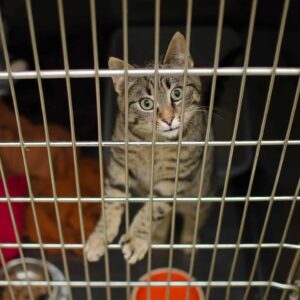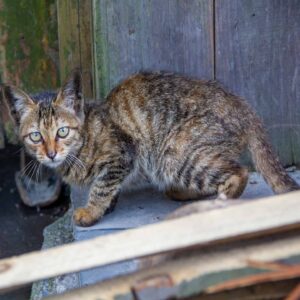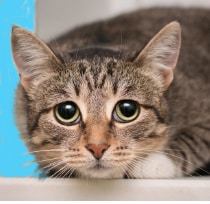I want your first cat or your next cat to be a happy cat – a new addition that is a pleasure to you and your family. Over the years, I have observed that kittens and cats that were born and reared in low-stress private homes, farms or suburban environments are less likely to have the psychological and general health scars related to early life trauma. Fewer and fewer cats are coming from those sources. Today, most new cats and kittens come from high stress municipal and private animal shelters, cat rescue groups and for-profit cat breeders. Those cats need homes too. But like the foster and adoptive parents of children in the state care systems, they often require a different mind set and personal gratification system from their new parents. (read here & here) I know that from personal experience. However if one of your primary pleasures in life is helping the less fortunate, homeless rescue cats and kittens are out there waiting for you.
I wrote this article with random-bred, run-of-the-mill house cats in mind – cats that share the gene pool of your neighborhood’s top dog tom cat. I have owned many and cared for thousands. They find their way to you from your local animal shelter or are offered to you by a neighbor or friend. It might be the one you child found on the way home from school or one that just appeared on your doorstep, meowed, cocked its head and gave you “that look”.

What About Pedigreed Cats?
When you opt to purchase your cat or kitten from a breeder or second hand through a pet shop, inbreeding and faulty genetics can come into play. Trendy cute genetics can be quite costly when it comes to your cat’s future health. Beware of the sales pitch “its a very rare breed“. The majority of genetic defects bred into pedigree cats are not nearly as obvious as in the sphinx cat in the photo. Cat fancier proclivities such as those of the CFA are weighed heavy toward body appearance. Body appearance is genetic. What you see in the cat might be pleasing to your eye, but it can have cruel consequences across the entire spectrum of physical health, psychological health and longevity. A few of those sought after purebred genetic traits are positive, but many are not. (read here, here, here, here, here & here)
The same early socializing factors with humans that influence temperament in random-bred house cats apply to purebred cats as well. Cat breeders I have dealt with were rarely inclined the spend sufficient social time with individual cats in their colonies.
I Want More Than One Cat
Fine. When you choose to have more than one cat member in your family, your chances for successful inter-cat relationships, a tranquil household and no stress-related health or behavioral issues are better if the two or three cats you choose are littermates. They do not necessarily need to be genetic sisters or brothers – just to be or have been kittens that grew up and nursed together on the same mother. If not possible, then at least cats from the same colony source that show the traits of friendship and a stable personality in their day-to-day setting and interactions. When you observe potential adoptee cats in a shelter environment or homeless cats in the field, observe them from a distance. Look for two or three mature cats that consistently stay close to each other – perhaps lying together in physical contact with one using the other as a pillow, or licking each other (allogrooming). Those cats are almost certain to make good housemates. (read here) I suggest that you leave with a solid commitment from the group or person caring for these cats that they will cheerfully accept the cat’s return if it fails to adapt to your new home setting over the coming months. Guilt and metrics are never a healthy motivations in relationships.
The Mission Of Animal Rescue
The primary mission of animal shelters and cat rescue groups is to place as many of their wards in homes as possible. The are under intense pressure to live by their “honor code”, which is to meet or exceed a 90% placement rate. Expand the photo above to understand that. Their focus is on “pet lifesaving”. Grants to those organizations can be dependent of achieving those “numerical goals”. If rescuing a cat is your primary goal, that is fine. God bless you. But if you have other desires and needs that are are important to you, it is not a rescue group’s primary mission to fulfill them. If a rescue home fails, it was not you that failed and it was not the cat that failed. It was bad judgement on the part of the shelter. Some things aren’t meant to be.

Choose A Cat Based On Its Personality, Not Its Visual Appeal
Some cat observers divide feline personalities into three general types. Those divisions in temperament between the three are not nearly as crisp as I list them below – no more than human personality types are crisply divided. However once a cat’s general personality is established, it rarely if ever changes.

 My favorite cat is the sociable, confident and easygoing feline. It will come up to you and meow or chirp even when you are a total stranger – like the one in the top image. When it does, the cat will carry its tail almost straight up – with a slight curl at the tip. After circling you, it will rub on your leg and purr. If you extend your hand, it will sniff it. It might roll over back and forth at your feet. It is curious and will chase a toy, a feather or a string if you offer it one. It passes by you again and again to be stroked and rub on your leg. As it does, it makes trill and chirping sounds. If you pull gently on its tail, it will simply turn around. If it is in an animal shelter cage, it is lounging near the front. It might yawn in your presence. These cats make excellent pets. They have loving relationships with their owners and usually get on well with their feline housemates.
My favorite cat is the sociable, confident and easygoing feline. It will come up to you and meow or chirp even when you are a total stranger – like the one in the top image. When it does, the cat will carry its tail almost straight up – with a slight curl at the tip. After circling you, it will rub on your leg and purr. If you extend your hand, it will sniff it. It might roll over back and forth at your feet. It is curious and will chase a toy, a feather or a string if you offer it one. It passes by you again and again to be stroked and rub on your leg. As it does, it makes trill and chirping sounds. If you pull gently on its tail, it will simply turn around. If it is in an animal shelter cage, it is lounging near the front. It might yawn in your presence. These cats make excellent pets. They have loving relationships with their owners and usually get on well with their feline housemates.

 The second type of cat is shy, suspicious and fearful. It rarely blinks. It will withdraw from you if you approach it. It resents handling. When forced into situations that are too intimate, it is likely to claw or bite in an attempt to escape. It is also likely to take a swipe at you if you gently pull on its tail. If it is in an animal shelter cage, it is in a rear corner. It is too tense to yawn in your presence. These cats were never properly socialized as kittens. They carry a lot of emotional baggage. When adopted, they are over-represented in cats with inter-cat and inter-owner issues.
The second type of cat is shy, suspicious and fearful. It rarely blinks. It will withdraw from you if you approach it. It resents handling. When forced into situations that are too intimate, it is likely to claw or bite in an attempt to escape. It is also likely to take a swipe at you if you gently pull on its tail. If it is in an animal shelter cage, it is in a rear corner. It is too tense to yawn in your presence. These cats were never properly socialized as kittens. They carry a lot of emotional baggage. When adopted, they are over-represented in cats with inter-cat and inter-owner issues.

 The third type of cat is excitable, nervous and tense. It ignores or is hostile other cats. It regards you with an intense stare. It stands its ground when approached and will spit, hiss or growl. Its only motivation to approach its caretaker is to be fed. These are the cats most likely to attack their owners and housemates. With time, they may learn to tolerate you; but they will never be affectionate to you.
The third type of cat is excitable, nervous and tense. It ignores or is hostile other cats. It regards you with an intense stare. It stands its ground when approached and will spit, hiss or growl. Its only motivation to approach its caretaker is to be fed. These are the cats most likely to attack their owners and housemates. With time, they may learn to tolerate you; but they will never be affectionate to you.
Standardized methods to classify a cat’s personality have been developed. But all are rather awkward and at least as inaccurate as human matchmaking services. Successful cat-to-owner and owner-to-cat compatibility goes far beyond standardized testing.

Are Cats That Don’t Pass Those Personality Tests All Fated To Become Problem Cats?
Not at all.
Animal shelters are places of turmoil for cats. Bright colors, wall prints and spotless stainless steel cages make animal shelters very presentable to human visitors. But they do nothing to impress cats. Even a very sociable cat is likely to be fearful initially in such an environment. The caretakers of these cats are in a conundrum. If they wait long enough to truly judge the temperament of the cats and kittens that come in, they cannot keep up with the inflow of new cats. If they maintain high numbers of cats under longer evaluation, they exhaust their financial resources and space. If they maintain incoming cats and cats emotionally chilling down in the same facilities, they experience periodic outbreaks of disease. (read here) If they keep cats long enough for them to revert to their best dispositions, other health issues can be discovered that require expensive veterinary care. Legitimate cat rescue groups almost never have deep pockets. Contrary to what most people suppose, your local shelter organizations receive little or no financial support from fat groups like the ASPCA, HSUS and the ones that advertise heavily on TV – at least none of the many one I have volunteered with ever did. Not only are the cats stressed by the realities of this situation; it is highly stressful to the truly dedicated people providing their care. (read here) Over the years I have seen the emotional exhaustion, staff turnover and negative effects on the general health of these wonderful folks who are on the front lines attempting to assist the animals. (read here & here) It is not that different in other high-stress, emotion-laden jobs that take a toll on one’s empathy. (read here) Is it any wonder that shelter staff is motivated to places as many cats in homes as they can, just as fast as they can? So for the very explainable reasons I just mentioned, what happens down the road is not their primary focus. That needs to be at least something you are aware of.

How Should I Introduce My New Cat To My Feline Family At Home?
If your cat will come from a shelter, spend some time looking over their available cats using some of the things I mentioned earlier to judge their underlying dispositions. Explain that you have several cats at home and that their getting along is something you cannot predict. Ask what will happen if that is the case. Sign an agreement with the staff once you know the terms of the adoption. Although it is standard dogma to do so, I prefer shelters that do not insist that you spay or neuter kittens too young. That brings up a whole different set of health issues later in life. (read here)
Be sure the cat is already free of fleas, ticks, internal parasites, ringworm and ear mites. The cat also needed to be confirmed feline leukemia and feline immunodeficiency virus negative if they are over about 6 months of age. Younger cats can be positive when their mother was positive – but go negative at about 6 month of age (earlier if it was just antibody present in the milk when they were nursing a positive mother) . Whether that will happen is quite unpredictable. Don”t let anyone tell you it isn’t. The possibility of either virus transferring to negative cats in your home is also unpredictable although all your cats need to be vaccinated against feline leukemia. ( read here, here & here) Vaccines do not provide immediate protection. I would give the vaccination to your cats at least 3 weeks before adopting another cat.
Later in the day, go to a store and buy a spacious, high-quality rigid plastic pet carrier. Not the cardboard ones the shelter might give you. Use a quality cat carrier to pick up your new cat. While you’re there, pick up a cat collar and have a tag with the cat’s name and your phone number made on the spot. Fearful cats are great escape artists. Don’t buy a break-away collar because hopefully you aren’t going to let your cats run loose outside unattended. Let the shelter staff adjust the new collar to a comfortable but snug fit. Have the staff bring the cat to you and place it in the carrier. Do not let them take the carrier to the back where it can pick up the odors and smells of other cats. Do it on a non-hectic morning for you and for their staff – after their feeding and cleaning chores are over. Do not bring your children to cat shelters unless they understand that you, not them, will choose which cat.
If you already have other cats at home, those that previously accepted newcomers are more likely to accept them again. The reverse is also true. Hopefully you have a room entirely separated (but not too distant) from the cats you already have. Preferably a room that is not a preferred location for one of your resident cats. It should be a quiet room in which you can place separate food, water, litter box, and enrichment activities with a hiding area. A cardboard box or two will do. Some find that the liberal use of Feliway™-type products in the new and resident cat’s quarters during this adjustment period to be helpful.
I would maintain that situation for about a week – perhaps more if the resident cats or the newcomer appear tense or agitated, perhaps less if everyone remains mellow. After the first day or two, depending on how calm things appear, take two small pieces of your apparel or one of your used small bathroom towels. Mark them with an indelible marker and stroke each cat down with one of them. Then place the item in a corner of the living areas of the opposite cats. If all goes well, repeat that round-robin from day to day until the cats show no interest in sniffing the cloth. I worry more about cats not getting along when they show no interest in sniffing the scents on the cloth than those that do.
Gradually increase the contact between the cats. Perhaps there is enough space under the door to the new cat’s room for your resident cat(s) to explore the new arrival. If not, devise some way for the cats to see each other and observe what happens. Which one’s tail goes up, which goes flat, whose ears lay back, which (if any) tense up, spit, growl or hiss. Rubbing the divider or purring is a very positive sign for either cat. The one that doesn’t is likely to be the most problematic with the new relationship.
When you do attempt to allow the cats free access to one another be sure to have extra food stations, litter boxes, water dishes and hiding areas. The more the better. You will need to chaperone them for a while until you are certain that they have become compatible. Play with both cats for short periods.
If altercations occur, go back to the previous living situation, give them more time and then try again. Keep towels and heavy gloves handy to separate cats if necessary. Once they appear to tolerate each others close presence, let them develop their relationship at their own pace. Don’t attempt to push them closer to each other or compete for resources, snacks and toys in an attempt to break the ice. That does not work and tends to be counter productive. You can read another veterinarian’s thoughts about introducing cats to each other here.
How Can I Tell If My New Cat or Older Resident Cats Are Uncomfortable In Their New Living Arrangements?
Cats that are uncomfortable with each other rarely interact. When they do, it is often aggressively over possession of choice resources (food, toys, favorite resting area, etc.) One will often leave the room when the other arrives. They often watch each other intently, giving none of the indications of inter-cat affection I mentioned earlier. They are tense when circumstances require that they be in close contact. They never sleep near each other nor do they groom each other. One or both may loose their toilet training. An occasional blink is a sign of a relaxed, contented cat. One rarely sees that in a cats uncomfortable in their living arrangements.
You are on the Vetspace animal health website
Visiting the products that you see displayed on this website help pay the cost of keeping these articles on the Internet.


